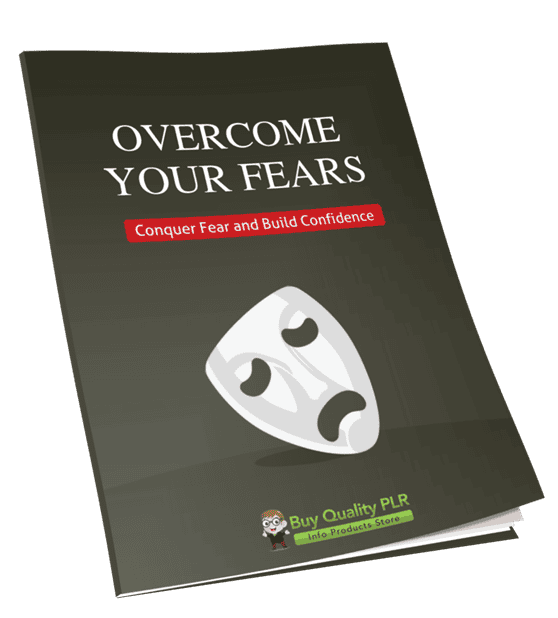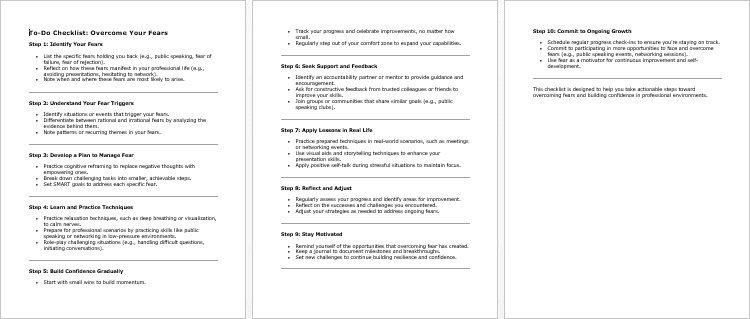
Overcome Your Fears PLR Course 43k Words
in Courage PLR , Fear PLR , PLR Checklists , PLR eBooks , PLR eCourses , PLR List Building Reports , Premium PLR , Premium PLR eBooks , Premium PLR Reports , Premium White Label Brandable PLR Coaching Courses , Private Label Rights Products , Self Help PLR , Self Help PLR eBooksChoose Your Desired Option(s)
has been added to your cart!
have been added to your cart!
#overcomefear #plrcourse #personalgrowth #selfimprovement #fearlessliving #mindsetshift #confidenceboost #selfhelp #mentalstrength #courage
Help Your Audience Conquer Fear, Build Confidence, and Achieve Personal and Professional Growth
Fear holds so many people back from achieving their full potential. Whether it’s the fear of public speaking, failure, rejection, networking, or stepping out of their comfort zone, overcoming these challenges is essential for both personal and professional success.
The Overcome Your Fears PLR Course is a comprehensive, step-by-step guide designed to help individuals identify, understand, and conquer their fears so they can develop unshakable confidence, improve communication skills, and take control of their future.
This fully customizable PLR course allows you to rebrand, resell, and repurpose the content as your own. If you are a coach, self-improvement blogger, content creator, course seller, or personal development expert, this course provides high-value content that you can monetize immediately.
Why Is This Course Valuable?
Fear is a universal challenge that affects people in many areas of life. Many struggle with self-doubt, low confidence, and anxiety about stepping outside their comfort zone. This course provides a clear, structured, and practical approach to overcoming fear, making it easier for individuals to break free from the mental barriers holding them back.
From changing limiting beliefs to mastering public speaking, networking with confidence, and facing everyday challenges fearlessly, this course offers proven techniques that deliver real results.
As a PLR buyer, you can profit from this in-demand topic by selling the course as your own, repurposing the content for blogs, emails, coaching programs, or even turning it into a physical product.
Presenting…
Overcome Your Fears PLR Course 43k Words
What’s Inside the Overcome Your Fears PLR Course?
This course is packed with actionable techniques, mindset shifts, and step-by-step strategies to help people break free from fear and build a more confident, fearless life.
Module 1: Understanding Fear and Its Impact
Before overcoming fear, it’s important to understand what it is and how it affects both personal and professional life. This module lays the groundwork for change by exploring the psychology of fear and why it holds people back.
- What Is Fear? – A deep dive into how fear is created in the brain, why it triggers emotional responses, and how it can impact decision-making and career growth.
- Common Professional and Personal Fears – Identifying and understanding public speaking anxiety, fear of failure, rejection, criticism, and social anxiety.
- Recognizing Fear Triggers – Learning how to spot patterns of fear, what causes them, and how to gain control over automatic fear responses.
- How Fear Limits Success – Exploring how self-doubt, hesitation, and avoidance can limit opportunities and growth in business and life.
Module 2: Transforming Fear into Confidence
Fear is not something to be eliminated—it can be transformed into a tool for motivation and success. This module helps participants shift their mindset, reframe negative thoughts, and use fear as fuel for growth.
- Reframing Negative Thoughts – How to turn self-doubt into self-belief by shifting perspective and using cognitive reframing techniques.
- Overcoming the Fear of Failure – Learning how failure is a stepping stone to success and how to embrace mistakes as part of growth.
- Small Steps, Big Changes – Setting realistic and manageable goals to gradually build confidence and expand comfort zones.
- Daily Confidence-Building Exercises – Simple yet powerful habits that create long-term courage and resilience.
Module 3: Mastering Public Speaking and Communication Skills
One of the most common fears is public speaking. Whether speaking in meetings, presenting ideas, or networking, communication plays a key role in success. This module helps individuals overcome anxiety related to speaking and expressing themselves in public settings.
- How to Stay Calm and Confident When Speaking – Techniques for managing stage fright, shaky voice, and nervousness before and during presentations.
- Structuring a Clear and Engaging Presentation – A step-by-step guide on crafting speeches, presentations, and pitches that engage and persuade.
- Using Body Language for Confidence – How posture, gestures, and voice control can transform nervous energy into a strong presence.
- Handling Unexpected Questions and Situations – Practical methods to stay composed, even in high-pressure business settings.
Module 4: Overcoming Social Anxiety and Networking Fears
For many, the idea of starting conversations, meeting new people, and networking at events can feel overwhelming. This module provides strategies to overcome social anxiety and build connections with ease.
- How to Make a Strong First Impression – The power of body language, tone of voice, and confidence in social interactions.
- Starting Conversations Without Awkwardness – Easy techniques to break the ice, keep conversations flowing, and engage meaningfully.
- Networking Without Fear – How to approach new people, introduce yourself, and create valuable professional relationships.
- Handling Rejection Without Losing Confidence – How to stay resilient, move on, and learn from experiences without fear of failure.
Module 5: Creating a Long-Term Fearless Mindset
Conquering fear isn’t a one-time fix—it requires continuous effort and self-improvement. This module focuses on maintaining a fearless mindset for long-term confidence and success.
- Developing a Fear-Conquering Routine – Building daily habits that reinforce courage and self-trust.
- Using Fear as a Growth Tool – How to use fear as motivation rather than a limitation.
- Setting and Achieving Bold Goals – How to dream big, take action, and move forward with unstoppable confidence.
- Accountability and Progress Tracking – Tools to monitor improvement, celebrate wins, and stay motivated.
Who Can Benefit from This Course?
This PLR course is ideal for anyone looking to overcome fear, build confidence, and achieve success. It is especially valuable for:
- Entrepreneurs & Business Owners – Helping them conquer fear of pitching ideas, networking, and making bold business decisions.
- Coaches, Trainers & Personal Development Experts – Providing them with a ready-made course to sell, teach, or use in coaching programs.
- Professionals & Leaders – Assisting them in public speaking, presentations, and leadership confidence.
- Content Creators & Bloggers – Allowing them to turn this content into courses, eBooks, podcasts, or membership material.
How You Can Profit from This PLR Course
This high-demand personal development course is completely done-for-you, making it easy to customize and turn into a profitable digital product.
- Sell it as an online course and keep 100% of the profits.
- Convert it into an eBook and sell it on Amazon, Etsy, or your website.
- Bundle it with other personal development products to create a premium package.
- Use it as a high-value lead magnet to grow your email list.
- Turn it into video or audio content for YouTube, webinars, or podcasts.
What You Get in This PLR Package
- Full-Length Course (42,214 Words) – A comprehensive, done-for-you course that’s ready to sell.
- Sales Page Copy (730 Words) – Professionally written content to start selling immediately.
- Checklists & FAQs – Easy-to-use guides to enhance user experience.
- 100% Editable Content – Customize, rebrand, and make it your own.
Start Selling & Profiting Today
Fear is something everyone struggles with—and that’s why this course will always be in demand. By offering this course, you can help people break free from their fears while growing your own digital product business.
Get your hands on this Overcome Your Fears PLR Course today and start selling immediately!
has been added to your cart!
have been added to your cart!
Here A Sample of Overcome Your Fears PLR Course
Course Goal: To empower professionals to conquer fears, enhance confidence, and develop strong communication skills, making them more effective in international business settings, meetings, presentations, and networking.
Module 1: Understanding Fear and Its Impact on Professional Life
Lesson 1: What Is Fear and Why Does It Hold Us Back?
Objective: Explore the concept of fear and its psychological and emotional impact on personal and professional life.
Step-by-Step Guide:
Define fear: what it is and how it affects decision-making and behavior.
Fear is a natural emotional response to a perceived threat or danger, whether physical or psychological. It is an instinctive reaction designed to protect us from harm by triggering the “fight or flight” response in the brain. This response prepares the body to either confront the danger (fight) or flee from it (flight). Fear can be based on real threats (such as facing a dangerous animal) or perceived threats (such as worrying about public speaking or failure), which can sometimes be irrational or disproportionate to the actual risk.
How Fear Affects Decision-Making and Behavior:
- Decision-Making:
- Paralysis by Analysis: Fear can cause overthinking and hesitation, making it difficult to make decisions. For example, a person might delay a decision because they are worried about making the wrong choice, fearing failure or disapproval.
- Risk Aversion: Fear often leads to avoiding risks, even when the potential benefits outweigh the potential downsides. This can manifest in situations like not speaking up in meetings, not pursuing new opportunities, or avoiding leadership roles out of fear of failure.
- Impulsive Decisions: On the flip side, fear can also lead to impulsive decisions driven by the need to avoid uncomfortable situations. For instance, someone might make a hasty decision to escape a fear of conflict or rejection, only to regret it later.
- Paralysis by Analysis: Fear can cause overthinking and hesitation, making it difficult to make decisions. For example, a person might delay a decision because they are worried about making the wrong choice, fearing failure or disapproval.
- Behavior:
- Avoidance: One of the most common behaviors fear drives is avoidance. For example, someone with a fear of public speaking may avoid opportunities to present in front of others, thereby limiting career advancement and personal growth.
- Procrastination: Fear of failure or imperfection can lead to procrastination, where individuals delay tasks because they’re afraid of not doing them perfectly or fear of judgment.
- Overcompensation: On occasion, fear can lead individuals to overcompensate in certain areas. For example, someone fearing criticism may become overly cautious, over-preparing for meetings or presentations, which can reduce their ability to respond flexibly and confidently.
- Avoidance: One of the most common behaviors fear drives is avoidance. For example, someone with a fear of public speaking may avoid opportunities to present in front of others, thereby limiting career advancement and personal growth.
In essence, fear impacts how we perceive situations, influence our choices, and shape our actions. When not managed, it can hinder personal and professional growth, keeping individuals from taking advantage of opportunities or making confident, informed decisions. However, when understood and addressed, fear can be transformed into a tool for growth and better decision-making.
Discuss common professional fears: public speaking, networking, performance anxiety, and fear of failure.
Common Professional Fears:
- Public Speaking:
- Description: One of the most common fears in the professional world is the fear of public speaking, also known as glossophobia. It’s the anxiety that arises when speaking in front of an audience, whether in meetings, presentations, or conferences. Even highly skilled professionals often feel nervous about speaking publicly, worrying about being judged, making mistakes, or not meeting expectations.
- Impact on Profession: This fear can limit career opportunities, as individuals may avoid presenting ideas, leading teams, or participating in important discussions. It can also negatively affect their ability to effectively communicate and influence others in meetings or interviews.
- Signs of Fear: Sweating, shaking, dry mouth, voice trembling, rapid heartbeat, and difficulty in articulating thoughts.
- Overcoming it: Gradual exposure, practice, and preparation can help reduce fear. Developing strong communication skills and mastering breathing and relaxation techniques before speaking can also ease anxiety.
- Description: One of the most common fears in the professional world is the fear of public speaking, also known as glossophobia. It’s the anxiety that arises when speaking in front of an audience, whether in meetings, presentations, or conferences. Even highly skilled professionals often feel nervous about speaking publicly, worrying about being judged, making mistakes, or not meeting expectations.
- Networking:
- Description: Networking fear is the anxiety professionals feel when interacting with others in business environments, such as conferences, social events, or informal gatherings. The fear of networking is often tied to worries about rejection, awkwardness, or not knowing what to say.
- Impact on Profession: Fear of networking can hold professionals back from forming important business relationships, gaining career opportunities, or advancing in their industries. Networking is essential for career growth, making this a significant barrier for those who avoid it.
- Signs of Fear: Avoiding eye contact, feeling tense or fidgety, struggling to introduce oneself, or feeling like you’re “out of place” in conversations.
- Overcoming it: Building confidence by preparing conversation starters, focusing on listening rather than speaking, and approaching networking with the mindset of learning from others rather than impressing them can help ease the fear.
- Description: Networking fear is the anxiety professionals feel when interacting with others in business environments, such as conferences, social events, or informal gatherings. The fear of networking is often tied to worries about rejection, awkwardness, or not knowing what to say.
- Performance Anxiety:
- Description: Performance anxiety is the fear of not performing well in high-pressure situations, such as meetings, client presentations, or even when managing a team. It can stem from a fear of underperforming, being judged, or letting others down. This fear can affect the way professionals prepare for and deliver results, often making them second-guess their abilities.
- Impact on Profession: This fear can lead to overthinking, self-doubt, or even procrastination, as professionals worry about the consequences of making mistakes. It can also affect the quality of their work or decision-making, especially in stressful environments.
- Signs of Fear: Nervousness, excessive sweating, a lack of focus, second-guessing oneself, and difficulty executing tasks even when well-prepared.
- Overcoming it: One of the best ways to tackle performance anxiety is through preparation, mindfulness, and focus. Setting realistic expectations, visualizing success, and reframing negative thoughts can help shift the focus away from fear to performance.
- Description: Performance anxiety is the fear of not performing well in high-pressure situations, such as meetings, client presentations, or even when managing a team. It can stem from a fear of underperforming, being judged, or letting others down. This fear can affect the way professionals prepare for and deliver results, often making them second-guess their abilities.
- Fear of Failure:
- Description: The fear of failure is one of the most pervasive fears professionals experience. This fear involves worrying about making mistakes or not meeting expectations, leading to a potential loss of reputation, job, or career opportunities. Professionals may fear that failing at something will have serious repercussions for their future success.
- Impact on Profession: This fear can prevent professionals from taking risks, exploring new ideas, or pushing themselves outside their comfort zone. It may result in missed opportunities for growth, innovation, and leadership roles. Fear of failure can also cause perfectionism, where professionals focus on avoiding mistakes rather than achieving success.
- Signs of Fear: Avoiding challenges, procrastination, over-preparing for tasks, excessive self-criticism, or not pursuing ambitious career goals.
- Overcoming it: Changing the mindset from viewing failure as a negative outcome to seeing it as a learning opportunity can help manage this fear. Practicing self-compassion, embracing small failures as steps toward growth, and setting realistic goals can encourage professionals to take calculated risks and build resilience.
- Description: The fear of failure is one of the most pervasive fears professionals experience. This fear involves worrying about making mistakes or not meeting expectations, leading to a potential loss of reputation, job, or career opportunities. Professionals may fear that failing at something will have serious repercussions for their future success.
Summary:
Each of these professional fears—public speaking, networking, performance anxiety, and fear of failure—can significantly impact a person’s career growth and job satisfaction. However, these fears are normal and can be managed with the right strategies, such as practice, preparation, and a mindset shift. Confronting and addressing these fears not only builds confidence but also enhances communication and leadership skills, which are critical for success in international business settings.
How Fear Manifests in Different Professional Scenarios:
Fear can show up in various ways depending on the professional setting. Whether it’s fear of public speaking, social interactions, or making decisions, each scenario brings out different reactions and behaviors. Let’s explore how fear manifests in some common professional scenarios:
1. In Meetings and Presentations:
- Manifestation of Fear:
- Physical Symptoms: Sweating, shaking hands, dry mouth, nervous fidgeting.
- Behavioral Symptoms: Avoiding eye contact, stammering or speaking too quickly, and relying heavily on notes or slides to avoid mistakes.
- Mental Symptoms: Overthinking responses, fear of being judged or misinterpreted, worrying about forgetting key points.
- Physical Symptoms: Sweating, shaking hands, dry mouth, nervous fidgeting.
- Impact on Performance: Fear can lead to a lack of clarity, reduced confidence, and poor communication. This may affect your ability to articulate ideas, engage your audience, or make persuasive points.
- Example Scenario: During a client presentation, you might freeze when asked an unexpected question, even though you’ve prepared well. This is a common manifestation of performance anxiety.
2. Networking Events:
- Manifestation of Fear:
- Physical Symptoms: Nervous tension, shallow breathing, and a tight stomach.
- Behavioral Symptoms: Avoiding initiating conversations, standing in groups without actively participating, or leaving early to avoid awkward social interactions.
- Mental Symptoms: Worrying about not having the right things to say, fearing rejection or not being able to make meaningful connections.
- Impact on Career: Fear of networking can prevent you from making important business connections, securing new clients, or finding mentorship opportunities, which are vital for career growth.
- Example Scenario: At a conference, you avoid approaching someone you admire because you fear coming off as inauthentic or not having enough value to add to the conversation.
3. Client Interactions:
- Manifestation of Fear:
- Physical Symptoms: Nervous sweating, a rapid heartbeat, and feeling overwhelmed.
- Behavioral Symptoms: Over-explaining your ideas, using filler words like “um” or “like,” or failing to set clear boundaries during negotiations or discussions.
- Mental Symptoms: Worrying about how clients perceive you, fearing criticism, and being afraid of making a wrong move that could jeopardize the relationship.
- Physical Symptoms: Nervous sweating, a rapid heartbeat, and feeling overwhelmed.
- Impact on Professional Relationships: Fear in client interactions can lead to misunderstandings, missed opportunities, or a loss of credibility. If you’re overly cautious, you may not be able to push back on unrealistic expectations or ask for the terms you deserve.
- Example Scenario: You might over-apologize or agree to terms you’re not comfortable with just to avoid confrontation or fear of losing a client.
4. Leadership and Team Management:
- Manifestation of Fear:
- Physical Symptoms: Tension in the body, stiff posture, shallow breathing.
- Behavioral Symptoms: Difficulty delegating tasks, micromanaging, or avoiding difficult conversations with team members.
- Mental Symptoms: Self-doubt about leadership abilities, fear of making decisions that affect team morale or productivity.
- Impact on Team Performance: Fear of leadership can lead to ineffective management, lack of trust from your team, and reduced team motivation. If you’re afraid of conflict or mistakes, you might avoid providing constructive feedback or making important decisions.
- Example Scenario: You avoid giving feedback to an underperforming team member because you fear they’ll become defensive or upset, thus failing to address an ongoing issue that could affect the team’s overall success.
5. Decision-Making and Risk-Taking:
- Manifestation of Fear:
- Physical Symptoms: Overthinking, feelings of anxiety, and indecisiveness.
- Behavioral Symptoms: Procrastination, excessive information gathering, or deferring decisions to others to avoid the responsibility of making the “wrong” choice.
- Mental Symptoms: Worrying about consequences, second-guessing yourself, and fearing negative outcomes or judgment from others.
- Physical Symptoms: Overthinking, feelings of anxiety, and indecisiveness.
- Impact on Career Progression: Fear of making mistakes or facing failure can prevent you from taking opportunities, such as leading projects, asking for promotions, or making bold business decisions that could drive your career forward.
- Example Scenario: When given a chance to take on a high-profile project, you hesitate because you fear not being able to deliver, even though you’re well-qualified for the task.
6. Job Interviews:
- Manifestation of Fear:
- Physical Symptoms: Sweating, shaking hands, flushed skin, dry mouth.
- Behavioral Symptoms: Speaking too fast, avoiding direct answers to questions, or being overly apologetic.
- Mental Symptoms: Worrying about making a good impression, fearing the interviewer’s judgment, or overthinking every response.
- Physical Symptoms: Sweating, shaking hands, flushed skin, dry mouth.
- Impact on Career Opportunities: Interview anxiety can affect your ability to present yourself confidently, making it harder to highlight your qualifications and experience. As a result, you may not get hired even if you’re a perfect fit for the role.
- Example Scenario: In a job interview, you may over-prepare your responses but end up sounding robotic, or become so nervous that you forget key details about your experience.
7. Handling Criticism or Feedback:
- Manifestation of Fear:
- Physical Symptoms: Tension in the body, flushed face, or feeling a lump in your throat.
- Behavioral Symptoms: Defensiveness, shutting down, or avoiding feedback altogether.
- Mental Symptoms: Anxiety about being judged, fear of letting others down, or worrying about what others think of your abilities.
- Physical Symptoms: Tension in the body, flushed face, or feeling a lump in your throat.
- Impact on Growth: Fear of criticism can prevent you from receiving valuable feedback that could improve your performance. It may also make you hesitant to take constructive criticism, which is necessary for professional growth.
- Example Scenario: When receiving feedback from a manager, you may become defensive, focusing more on justifying your actions than on learning how to improve.
Summary:
Fear manifests in different ways depending on the professional context. Whether it’s during public speaking, networking, performance reviews, or leadership decisions, the physical and psychological symptoms of fear can significantly affect how professionals behave and make decisions. Understanding how fear shows up in various situations is the first step to overcoming it. By recognizing these patterns, you can take proactive steps to manage fear, increase your confidence, and perform better in high-pressure environments.
We’re also giving these extra bonuses
Overcome Your Fears – Checklist

Overcome Your Fears – FAQs

Overcome Your Fears – Salespage Content

Package Details:
Word Count: 42 214 Words
Number of Pages: 192
Overcome Your Fears – Bonus Content
Checklist
Word Count: 401 words
FAQs
Word Count: 669 words
Salespage Content
Word Count: 730 words
Total Word Count: 44 014 Words
Your PLR License Terms
PERMISSIONS: What Can You Do With These Materials?
Sell the content basically as it is (with some minor tweaks to make it “yours”).
If you are going to claim copyright to anything created with this content, then you must substantially change at 75% of the content to distinguish yourself from other licensees.
Break up the content into small portions to sell as individual reports for $10-$20 each.
Bundle the content with other existing content to create larger products for $47-$97 each.
Setup your own membership site with the content and generate monthly residual payments!
Take the content and convert it into a multiple-week “eclass” that you charge $297-$497 to access!
Use the content to create a “physical” product that you sell for premium prices!
Convert it to audios, videos, membership site content and more.
Excerpt and / or edit portions of the content to give away for free as blog posts, reports, etc. to use as lead magnets, incentives and more!
Create your own original product from it, set it up at a site and “flip” the site for megabucks!
RESTRICTIONS: What Can’t You Do With These Materials?
To protect the value of these products, you may not pass on the rights to your customers. This means that your customers may not have PLR rights or reprint / resell rights passed on to them.
You may not pass on any kind of licensing (PLR, reprint / resell, etc.) to ANY offer created from ANY PORTION OF this content that would allow additional people to sell or give away any portion of the content contained in this package.
You may not offer 100% commission to affiliates selling your version / copy of this product. The maximum affiliate commission you may pay out for offers created that include parts of this content is 75%.
You are not permitted to give the complete materials away in their current state for free – they must be sold. They must be excerpted and / or edited to be given away, unless otherwise noted. Example: You ARE permitted to excerpt portions of content for blog posts, lead magnets, etc.
You may not add this content to any part of an existing customer order that would not require them to make an additional purchase. (IE You cannot add it to a package, membership site, etc. that customers have ALREADY paid for.)
Share Now!












